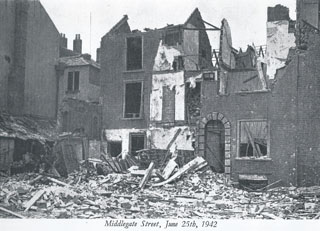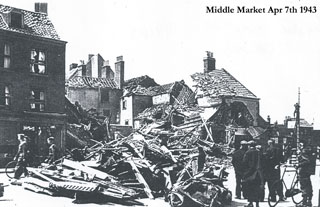Great Yarmouth History
The Rows 1939 - 1945
The fate of many of the Yarmouth Rows was decided with the introduction of the Ministry of Health Housing Act of 1930, when the town was divided into slum clearance areas No 1 and No 2. Great debates took place between 1930 and the outbreak of the War, with articles being written in local papers by such luminaries as R. H. Teasdel of the Norfolk and Norwich Archaeological Society and A.R.Powys of the Society for the Preservation of Ancient Buildings. Of course not forgetting those wonderful sketches of Claude Messent entitled "The Rows of Great Yarmouth" which appeared weekly in the Yarmouth Independent until August 1939.

The War for Great Yarmouth started on the 23rd of August 1939. From then, the town rapidly changed to a war footing in earnest with the arrival on the 1st to the 3rd of September of ships laden with evacuees from London and surrounding areas. In total over 7,000 people landed in Great Yarmouth. They stayed in the town for several days until being transported inland to safer areas. This operation also involved a massive movement of food blankets, provisions, clothing and many other items required for day to day life.

Holidaymakers in the town soon realised the seriousness of the situation and left for home when the evacuees starting to arrive. The holiday trade soon went downhill and would remain depressed for the remainder of the war years as was to be expected. Many of the town's hotels were taken over by the Armed Forces and the character of the town changed. Another casualty of the war was the Herring Fishing Industry which ceased to operate. The Royal Navy commandeered many of the drifters for mine sweeping duties as part of the Royal Naval Patrol Service. There is no doubt that the war saw the beginning of the end for the Rows. In 1941 large areas of Middlegate were devastated by German bombing.
In early 1939, the Germans had taken aerial photographs of what was to be their main target areas in Great Yarmouth. Unbelievably, using tourist guides and brochures to pinpoint potential landmarks and targets. The German Luftwaffe carried out more raids on Great Yarmouth than any other coastal town. Most damage and destruction was caused between 1940 and 1941 and effectively ended a town plan that had survived since the eleventh century.